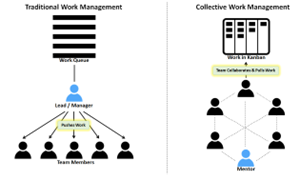Let’s talk about Agile enablement in IT Infrastructure Services and Operations.
“Agile” has been a buzzword in the IT landscape for at least a decade. Many companies have adopted Agile methods to accelerate application development and implemented various best practices by integrating Agile methods with other frameworks such as DevOps, Lean, and Kanban to build an ecosystem for application development. But can we implement Agile methods, practices, and principles in IT infrastructure support services and operations? The answer is “yes” to Agile enablement.
This article looks at what’s possible for Agile enablement, including for IT service management (ITSM).
Can we implement #Agile methods, practices, and principles in IT infrastructure support services and operations? The answer is 'yes', and this article explores. #ITSM #servicedesk Click To TweetBringing Agile enablement into IT infrastructure operations
ITIL/ITSM processes tell you “WHAT” to perform in each process, with inputs, activities, and outputs defined. All of the process procedures are based on “HOW” you should perform those activities within the process. This is a key area where we can bring Agile principles, practices, and methods, or Agile enablement, effectively into IT infrastructure operations.
For example, in the traditional IT service desk incident or request logging process, a service desk agent would use a ticketing tool to register the incident or service request and a queue management portal in the ticketing tool to monitor the request or incident. Sometimes, a service desk lead or shift lead will assign the incoming tickets to respective service desk agents. This procedure or practice usually delays the request/incident being handled within priority-based targets.
This scenario can be addressed through Agile practices called “Collective Work Management” along with digital Kanban boards, and most ITSM tools now have inbuilt digital Kanban boards. Below are a few Agile practices tailor-made to “fit for purpose” in IT Infra Operations:
- Collective work management
- Visualization of work
- Daily Scrum for Operations
- Retrospective for Operations
- Value delivery through Sprint methods
1. Collective Work Management
This Agile enablement practice aims to bring a cultural shift by blending a bottom-up approach with the existing top-down approach for planning and executing work. Using Kanban physical and digital boards is a significant enabler of this practice. It displays “To Do—Doing—Done” and is an industry-wide practice for work progress visualization. As a minimum, a wall or a physical whiteboard may be used to maintain a Kanban board. But there are also digital dashboards in ITSM tools for when teams are distributed.
It aims to leverage the power of collectivity by:
- Empowering team members by involving them in work planning and decision-making in addition to execution
- Enabling inter-tower/inter-portfolio collaboration by emphasizing the collaboration opportunities
- Creating a collective ownership mindset by prioritizing team success over individual success.

The benefits of collective work management using Kanban include that:
- Empowerment increases the motivation levels of team members
- Collaboration among the team members helps in efficiently managing the work
- Collaboration among different towers/portfolios helps in avoiding the inefficiency caused by the work moving back and forth among the towers/portfolios.
2. The Visualization of Work
This Agile enablement practice helps the operations/support functions to visually monitor and track the operational activities/performance through digital Kanban boards or any other visual performance scorecard. It motivates a culture of moving away from manual reporting, tracking, and monitoring.
The benefits of work visualization include that it:
- Provides one shared understanding of the progress for all (both the team and stakeholders)
- Increases transparency by exposing key failure points, bottlenecks, and dependencies
- Optimizes the workflow, thereby improving the cycle time.
- Team members volunteer and pick up pending work when they see the To-Do list
- Improves the associate satisfaction index when they see their names on the wall of fame
- Reduces the repeated mistakes that may result in revenue loss
- Helps the team to meet the service level agreements (SLAs) agreed with the customer.
3. Daily Scrum for Operations
A daily scrum meeting is a good option to replace traditional daily call/stand-up meetings in IT infra support and operations. One of the major drawbacks of traditional daily call meetings is that there’s no structured agenda or fixed time period defined or followed. Meetings often go beyond their purpose, and teams may try to solve the problem rather than collaborate to understand productivity or the BAU status.
Scrum.org defines a daily scrum as:
“Purpose of the Daily Scrum is to inspect progress toward the Sprint Goal and adapt the Sprint Backlog as necessary, adjusting the upcoming planned work.”
It answers the following questions:
- What did you do yesterday?
- What will you do today?
- Are there any impediments in your way?
The definition can be fine-tuned for IT infrastructure support operations with the team answering the three questions based on their daily IT operations/BAU tasks they are working on.
The benefits of daily scrum meetings to Agile enablement include:
- Improving overall communication and collaboration among team members
- Identifying challenges and making quick decisions
- Enabling transparency among team members
- Saving the time and productivity of team members due to it being a time-boxed event.
4. Retrospective for Operations
Retrospectives focus on identifying improvement opportunities in Scrum practices (processes and tools). Usually, a retrospective is conducted at the end of the Sprint in a development environment. This practice can also be leveraged in IT infrastructure operations, where meetings can be held fortnightly or once a month, and all team members can come together to discuss the following questions:
- What were the positives (what went well)?
- What were the negatives (what did not go well)?
- Suggestions for improvement (areas of improvement)?
The benefits of retrospectives for Agile enablement of operations include:
- Enabling culture change and transparency
- Improving team collaboration in identifying areas of improvement
- Goal orientation
- Moving away from the traditional way of working by cultivating the practice of “inspect and adapt.”
5. Value Delivery Through Sprint Methods
This Agile enablement practice aims to create value-based outcomes through IT operations/BAU improvement opportunities. It’s accomplished by using agile scrum methods in executing the improvement opportunities.
The practice is divided into three sub-categories:
- Identification of improvement opportunities
- Formation of Scrum teams in IT operations
- Delivery of improvement opportunities through Sprint methods
Identifying Agile enablement improvement opportunities
Improvement opportunities can be identified through various sources in BAU. Each idea should be prioritized based on value-based outcomes, tangible and intangible benefits, and impact on the customer. Each BAU team is responsible for maintaining a list of improvement opportunities.
Improvement opportunities should be maintained at two levels:
- Project Value Log (PVL) – where all the ideas are gathered and prioritized
- Sprint Improvement Charter (SIC) – the business case, value delivered, sprint milestones, goals, and Minimum Viable Products (MVPs).
Formation of Scrum teams in IT operations
A Scrum team can be formed within the existing operations team to work on the improvement opportunities. A Scrum team must have the following three roles:
- Product Owner – A person with the vision and complete understanding of the improvement opportunity. Any team member with the vision of the opportunity can act as a Product Owner.
- Scrum Master – A person who can facilitate the Sprint events and enable the Scrum team to work efficiently.
- Team Members – Persons who can work on the improvement opportunities and create a working increment by the end of the Sprint
The formation of a Scrum team and effort spent on the Scrum should not affect the BAU/operational activities.
The benefits for Agile enablement include:
- Continuous improvement – As the practice builds a culture of constantly pursuing incremental improvements, it will result in continuous improvement.
- Culture change – It will allow teams to change their behavior and mindset from traditional work culture to an agile way of working.
Delivery of Agile enablement improvement opportunities through Sprint methods
Identified improvement opportunities are implemented in short time-boxed iterations and deliver early value in the form of MVPs. The following are the key attributes of Sprints:
- Sprint duration must be 1-4 weeks. The team can agree on a Sprint duration based on the complexity, dependencies, and size of the improvement opportunities.
- Sprints must include the events: Sprint Planning, Daily Scrum, Sprint Review, and Sprint Retrospective.
- Sprints must generate the artifacts: Scrum improvement charter containing a business case, value delivered, in-scope and out-of-scope, milestones, sprint-level goals, and MVPs.
The benefits include:
- Early value delivery – Short duration of the Sprint helps deliver the value early.
- Early feedback – Usage of MVPs by the stakeholders helps get valuable early feedback.
Implementing Agile practices in IT Infrastructure Services and Operations is just the beginning. The optimal adoption of agile methods for Agile enablement is only possible when you understand the organization’s environment, operations culture, and people mindset. There should be a strong commitment from senior leadership executives to implement organizational change management initiatives across the IT organization to help bring cultural change and move it from just “doing” Agile to “being” Agile.
Further Reading
Rahavendran RS
Rahavendran is an ITSM thought leader and Agile practitioner, ITIL® V3 Expert, ITIL 4 Foundation and Cloud Credential Certified ( PCSM ) professional with strong experience in providing quality ITSM solutions to customers from various business verticals.
Has vast experience in architecture of service management solutions, has lead team of process and tool consultants in designing and deploying ITSM processes at all layers from strategy to operational, defining governance models, continual improvement initiatives and corresponding tools for various clients across the globe.

